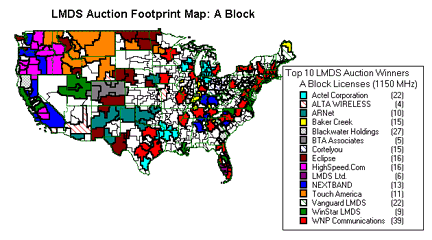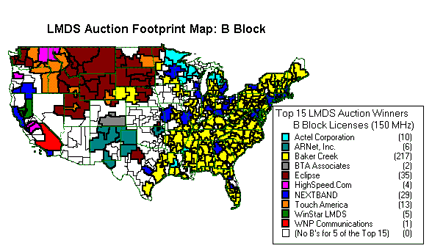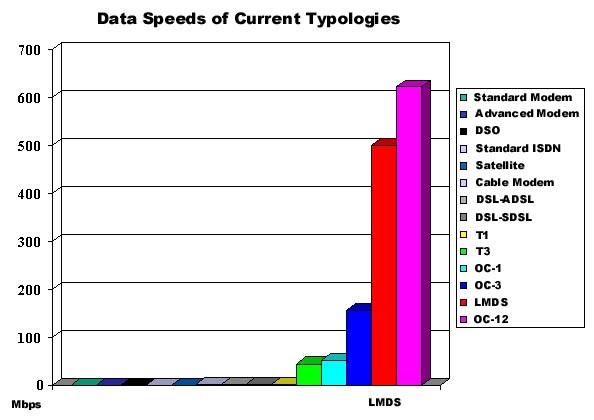
What is LMDS?
The term LMDS stands for Local Multipoint Distribution Service. LMDS uses microwave signals to transmit voice, video, and data signals using low power which can reach distances no greater than a five mile range. It is a wireless broadband service that relies on microwave radios to send large amounts of information between each of the radios at very high speeds. It operates between the 28Ghz & 29Ghz bands (Specifically): 27.50Ghz - 28.35Ghz & 29.10Ghz - 29.25Ghz & 30.00Ghz & 31.075Ghz - 31.225Ghz. More information can be found by reviewing the "What is LMDS?" section on this web site or by downloading the overview created by Nortel Networks in a .pdf format for the IEC organization. In addition, the Power Point slide presentation created by the Stategis Group is another good source of information.
How does LMDS work?
Microwave radios designed to be used with LMDS are installed at two separate sites which are within a five mile range of each other. One of the radios is installed at the LMDS Hub or station and the other is installed at the customers site. The two radios can then transmit very large amounts of information between the two locations. The Hub or station is located at a key position to interface directly with land line fiber optic backbones as well as standard telephony. Video conferencing, Voice, Data, Internet access, and TV signals can all be provided even at the same time through this wireless service. Publications also provide information on LMDS and are listed under the resource section at the following link.
There is an LMDS study that was conducted in 1997 which is available for review in a .pdf format. In addition, a LMDS survey is available for download in a .pdf format as well.
There is an LMDS document created in 1997 by HP which is available for review in a .pdf format.
Why would I want to use LMDS?
One situation might occur when a large company has buildings which are spread out over a campus. However, a portion of the campus is divided by a freeway. In this example it is not cost effective to be able have land lines installed under the freeway to allow communication to the other half of the campus. LMDS radios can be installed on either side of the freeway to enable communications which were previously not feasible. In addition, the radios can be installed on each building throughout the campus to have direct communication internally rather than using the local phone company.
Another situation that may occur is a new high rise that is in need of fiber optic service. However, the building is far from the local fiber ring and it would take a large amount of money and over a year to have it installed. LMDS radios can be installed in as little as a weeks time and can provide fiber optic like services.
Viginia Tech purchased LMDS licenses and partnered with an equipment provider and has systems running.
How did companies become involved in LMDS?
The FCC auctioned specific areas of the US which allocated over 1 Ghz of spectrum to be used between the 28 Ghz - 31 Ghz band for LMDS. The winner of the auction for each of the areas is allowed to operate LMDS. More information about the auction can be found on the FCC web page.
- Click here to download a list of specific areas in a .pdf format.
- Click here to download a list of the bidders from auction #17 in a .xls format.
- Click here to download a secondary list of the bidders from auction #23 in a .xls format.
- Click here to download a list of the owners of specific areas from auction #17 in a .xls format.
- Click here to download a secondary list of the owners of specific areas from auction #23 in a .xls format.
- Click here to download license information in a .xls format.
How can I obtain service using LMDS for my company?
Finding who the owner of the license to operate LMDS in your area is the first step. The FCC provides a list of license owners for each area and it is available for review from their web page.
- Click here to download licensee information in a .pdf format.
- Click here to download a list of specific areas in a .pdf format.
Who is who in LMDS?
- Click here to download a list of specific areas and licensee information in a .pdf format.
Below is a list of the top 15 LMDS licensee's as reported by Simmons Associates. However, the list has been updated after a number of mergers and sales.
LMDS AUCTION TOP 15 SPECTRUM WINNERS
| Rank | Update | Bidder Name | Total MHz/Pops | $Hi Bids Rank | BUs Won Rank | MHz/Pops Rank | Net Pops Rank | Hi $/BU Rank |
| 1. | Nextlink | WNP Communications Inc. | 106,286,050,150 | 1 | 1 | 1 | 1 | 53 |
| NEXTBAND Communications | 42,100,985,250 | 2 | 2 | 2 | 2 | 29 | ||
| 1. | Partially owned by Nextlink | HighSpeed Comm. LLC | 4,886,458,400 | 16 | 10 | 11 | 14 | 73 |
| 1. | Partially owned by HighSpeed & Nextlink | BTA Associates | 3,538,043,400 | 6 | 11 | 13 | 17 | 23 |
| 2. | WinStar LMDS LLC | 17,199,065,450 | 3 | 3 | 3 | 4 | 39 | |
| 3. | Adelphia Business solutions | Baker Creek Communications | 16,208,315,300 | 4 | 5 | 4 | 3 | 40 |
| 4. | CoreCom Ltd. | Cortelyou Communications Co. | 12,160,079,300 | 5 | 4 | 5 | 7 | 45 |
| 5. | CenturyTel | Actel Corp. | 9,390,201,750 | 12 | 7 | 6 | 6 | 61 |
| 6. | AT&T Wireless Services Inc. | Vanguard LMDS Corp. | 8,189,419,100 | 13 | 8 | 7 | 10 | 58 |
| 7. | EchoStar | ALTA Wireless Inc. | 7,873,226,600 | 7 | 6 | 8 | 11 | 52 |
| 8. | ARNet Inc. | 7,336,084,150 | 9 | 9 | 9 | 13 | 46 | |
| 9. | Telemax Communications | Blackwater Holdings LLC | 5,266,682,600 | 21 | 12 | 10 | 15 | 80 |
| 10. | Western Wireless Corp. | Eclipse Communications Corp. | 4,234,434,250 | 8 | 13 | 12 | 5 | 22 |
| 11. | Touch America Inc. | 2,791,837,100 | 14 | 14 | 14 | 16 | 28 | |
| 12. | Wireless Access Network | LMDS Ltd. | 2,627,254,350 | 24 | 15 | 15 | 19 | 84 |
| Top 15 Totals: | 250,088,137,150 | |||||||
|
Source: Simmons Associates |
||||||||


Image Source: Simmons Associates
How fast is LMDS compared to other current technologies?
LMDS is extremely fast compared to dial-up modems, cable modems, DSL, T-1 lines, Frame Relay, and ISDN communications. In addition to being fast, LMDS has been allocated an enormous bandwidth of spectrum. This will allow more data to travel faster between two given points similar to why larger water pipes are used to carry a larger volume of water to areas that require it. Below is a chart displaying the relationship between the current technologies. If you haven't heard of the other technologies listed such as OC-3 then don't feel bad because they are typically only used for huge junction points in telephony networks. To give you an example, co-location companies use multiple OC-3's to deliver portals for the Internet that house and run the servers for such companies as Hotbot, Yahoo, Excite, etc...

What is the potential for LMDS?
LMDS is a wireless communications tool with an enormous bandwidth. In addition, it can be rapidly deployed to provide service in most cases in less than a few weeks. These key features will allow LMDS to become even more popular and more widely used as time goes on. It will be a reliable source to alleviate the never ending need for more bandwidth. With the overwhelming attention on the Internet people can now understand why bandwidth is important and how increased bandwidth provides better performance when using the Internet.
"Pioneer Consulting estimates that the market for local multipoint distribution services networks could reach $6.5 billion in the United States in 2007, compared with about $96.1 million this year." Source: Wireless Week
"LMDS will account for 75 percent of total subscriber revenues in 2000, growing from $433 million this year to $6.6 billion in 2005, Fuertes says." Source: Wireless Week
"ABI's forecasts for fixed wireless broadband growth are echoed by other analysts. International Data Corp., in a recent report, says the U.S. market for such services is expected to grow from $767 million in 1999 to $7.4 billion in 2003." Source: Wireless Week

Source: The Strategis Group
What are LMDS licenses worth?
This is a difficult question to answer. There are a number of companies that specialize in calculating the estimated value of LMDS licenses. However, the estimated values vary between the different companies. They also seem to be better at forecasting the amount of revenues to be potentially generated in years to come rather than estimating the current value of a license. However, we have not been able to find a profitable business model. When one becomes available, we would be happy to display the potential values.
CURRENT MARKET 2007:
The projected values in the early 2000's are not remotely accurate in 2007. Most of the licenee's that deployed in early 2001 went bankrupt. A few CLEC's were able to survive typically because of having an existing customer base in addition to deploying LMDS. The equipment that was deployed is now obsolete and most of the manufacturers are out of business. There have been no known significant technological break throughs to allow manufacturers to produce more efficient equipment and at a lower cost.
I have offered to allow State, local and city agencies the opportunity to utilize spectrum for little or no cost in an attempt to satisfy the FCC's renewal requirement but have had no interest. Currently, we are seeking to find any avaiable community use to utilize the spectrum with the intent to retain the licenses.
My personal view is that LMDS spectrum is similar to owning beach front property. However, a large hurricane swept over the area and the interest or demand to revitalize and rebuild have not been greater than the costs associated with doing so. The intent of this site is to allow all LMDS licensses as well as financial investors, manufacturers and industry related companies to join together to promote the use of the LMDS spectrum.
AFTERMATH:
The major deployment of LMDS has not occurred. A number of market factors combined with the shift in economy and lack of potential demand appear to be the cause. I would like to see major deployment and successful use of the spectrum throughout the US. However, it is unclear as to the appropiate method and timing for the venture. This is a good representation the LMDS market place: Wikipedia
![]()